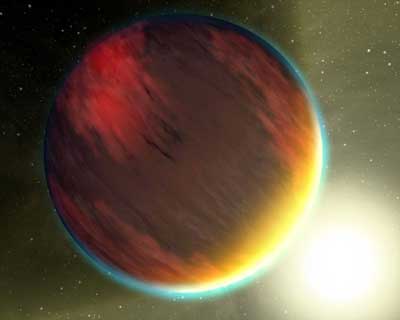Associate Professor Vivien Parmentier studies the atmospheric composition of planets orbiting other stars. Here he explains how, in an international first, he and a team of researchers used a new instrument to measure how many atoms of carbon and oxygen are present in the planet WASP-77Ab, 340 light-years away. The unparalleled precision of this measurement opens new avenue to understand how planets form and why so many planetary systems are different from our own.

Credit: NASA/JPL-Caltech
The quest for our origins has recently expanded with the discovery of exoplanet systems. These planetary systems orbiting other stars allow us to place the solar system into a broader context and to understand how unique – or common – we are in the grand scheme of things. Most planetary systems we have found are very different from our own. For example, some have Jupiter-sized planets that orbit their stars much closer than any of the solar-system planets orbit the sun! These so-called ‘hot Jupiters’ are now searing hot, with temperatures greater than 1,000°C, but they likely formed in the cold, outer regions of the formation disk and migrated towards the inner regions afterwards. If such a hot Jupiter had formed and migrated towards the sun in our own solar-system it would have likely sent Earth and all the other inner planets crashing in on the sun during its migration, making for a poor start for humanity.
Pinpointing a planet's place of birth
Measuring the abundance of elements in a planetary atmosphere – such as determining how many atoms of oxygen or carbon are present – helps us to pinpoint the planet’s place of birth and thus understand better its history. Planets form in a disk of gas and dust. The further away from its star a planet forms, the colder it is; it also means that many of the chemical elements in its surrounding atmosphere are frozen. Frozen solids can travel towards the hotter parts of the disk where they evaporate, which increases how much of these elements are available to form a planet. Thus measuring the amounts of chemicals in a giant planet atmosphere can tell us about where it formed. Carbon and oxygen are very good tracers of this process; because they freeze at different temperatures, measuring the abundance of both of them allow us to determine more precisely where the planet formed.
Up until now, measuring elemental abundance in exoplanet atmospheres relied mainly on the Hubble Space Telescope. However, this telescope is mainly sensitive to the amount of water which means it can tell us how many atoms of oxygen there are but not how many atoms of carbon. On the contrary, the oxygen abundance is extremely difficult to measure in solar-system planets while the carbon abundance is much easier. The reason is that these planets are much, much cooler than the hot Jupiters: Jupiter is roughly -150°C whereas a typical hot Jupiter is hotter than 1,500°C! As a consequence, the water in Jupiter is entirely condensed into clouds that form much deeper than the visible layer of the planet.
A novel instrument
In our paper, A solar C/O and sub-solar metallicity in a hot Jupiter atmosphere, we used a novel instrument (IGRINS) on the Gemini telescope to measure very precisely the abundance of BOTH carbon and oxygen in the hot Jupiter WASP-77Ab. Our instrument takes the light coming from the planet and splits it into 45,000 different colours – exactly like a rainbow splits the light of the sun into multiple colours. Molecules such as water and carbon monoxide absorb very specific colours, meaning that these colours are missing from the exoplanet rainbow we create. Our instrument is so precise that several hundreds of these missing colours can be measured, showing the very precise and unambiguous fingerprint of each molecule.
Our results show that this planet lacks both oxygen and carbon compared to what we measure in our solar-system planets. This points towards a different formation mechanism for our own Jupiter and the hot Jupiter WASP-77B, showing a pathway to understand better why Jupiter didn't travel closer to the sun and destroy us on the way.
What I find incredible is that our measurement of the amount of carbon in a planet that is more than 300 light-years away is almost as precise as the measurements that we get for solar-system planets, that are comparatively next door. Jupiter is roughly 6 million times closer to us than WASP-77Ab so if Jupiter was where your neighbour’s house is just a few metres away, WASP-77Ab would be a house in Sydney, Australia!
A solar C/O and sub-solar metallicity in a hot Jupiter atmosphere, Line et al, Nature, 598, 27 October 2021
Did you know?
Hot Jupiters are gaseous planets the size of Jupiter but orbit more than ten times closer to their star than Earth orbtis from the sun.
IGRINS stands for Immersion GRating INfrared Spectrometer. It is an instrument attached to the 8m Gemini telescope situated in Chile.
A light-year is the distance travelled by light during a year. One light-year is equal to 6 thousand billion miles.
Exoplanets are often named after telescope that discovered them. The WASP instrument (Wide Angle Search for Planets) is operated mainly from the UK by Warwick University and Keele University.

